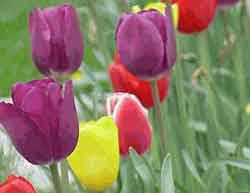
Holland is world renowned for their colorful tulips. Ask anyone, anywhere, to name things that are definitely Dutch, and the answer will invariably include not only windmills and wooden shoes, but most definitely tulips. Today almost half of Holland's 44,430 acres of flower bulb farms are dedicated to them!
The Promise of Spring
The history of tulips is as colorful as the flowers. In the 1600s, tulips were pleasures only the very wealthy could enjoy. Rare and beautiful, they were status symbols of European aristocrats. Then, a buying mania exploded. By 1624, the craze had reached such epic proportions that a single bulb fetched a whopping 4,500 guilders ($2,250 U.S.), plus a horse and carriage! Reaching its heyday in the years 1634 to 1637, the period known as Tulipomania is often compared to the stock market craze of the 1920s.
Despite their stately appearance, tulips are no longer confined to the realm of the aristocracy; instead, they have become one of the most popular of the spring-flowering bulbs. There's a Dutch saying that every bulb holds a promise--a promise of a world alive with color and good cheer. Certainly, the exuberant colors and dependable flowering of tulips fill that promise.
Types of Tulips
Although it isn't critical to know the various classifications of tulips, understanding how they're categorized can help you choose the right variety for your garden. For example, tulip classes vary in height, bloom time, and best uses. Here are some common tulip classifications.
Species Tulips
Species tulips are a tough, low growing bulbs that look great naturalized in beds, around perennials, and among trees and shrubs. They only grow 6 to 10 inches tall and tolerate part shade as well as full sun. They flower early in the season and come in a variety of colors. They also grow well in containers combined with various annuals and low growing perennials.
Double Late Tulips
Double late tulips are also known as peony-flowered tulips, alluding to their large double flowers. Plant these in a sheltered location so the huge blooms won't be damaged by strong winds. You may want to stake individual blooms, since, like their namesake, peonies, they can be top heavy and tend to flop over. But their spectacular flowers make it worth the extra care! They product one huge flower per stem.
Darwin Tulips
Darwin hybrid tulips are notable for their large, bright flowers and long stems. Because of these qualities, they make excellent cut flowers. Although the stems are quite sturdy, it's still best to plant them in a spot with some protection from strong winds, to prevent these tall flowers from toppling. They generally flower mid-season, producing a single flower per stem.
Parrot Tulips
Parrot tulips have large, unusually-shaped flowers with fringed, curled and twisted petals. In full sun the flowers open wide for a very striking display, and they are available in a variety of colors and patterns. Because their heritage varies, the bloom time and height also varies among the cultivars. These large flowers do best in a sheltered location, and make striking additions to bouquets.
Fosteriana Tulips
Fosteriana tulips originated as a wild species found in the mountainous areas of Central Asia. These early-flowering tulips are known for their intensely-colored flowers that open wide in the sunshine. They are versatile, and can be used in mass plantings, cut for bouquets, or forced for early bloom. They are also an excellent choice for naturalizing.